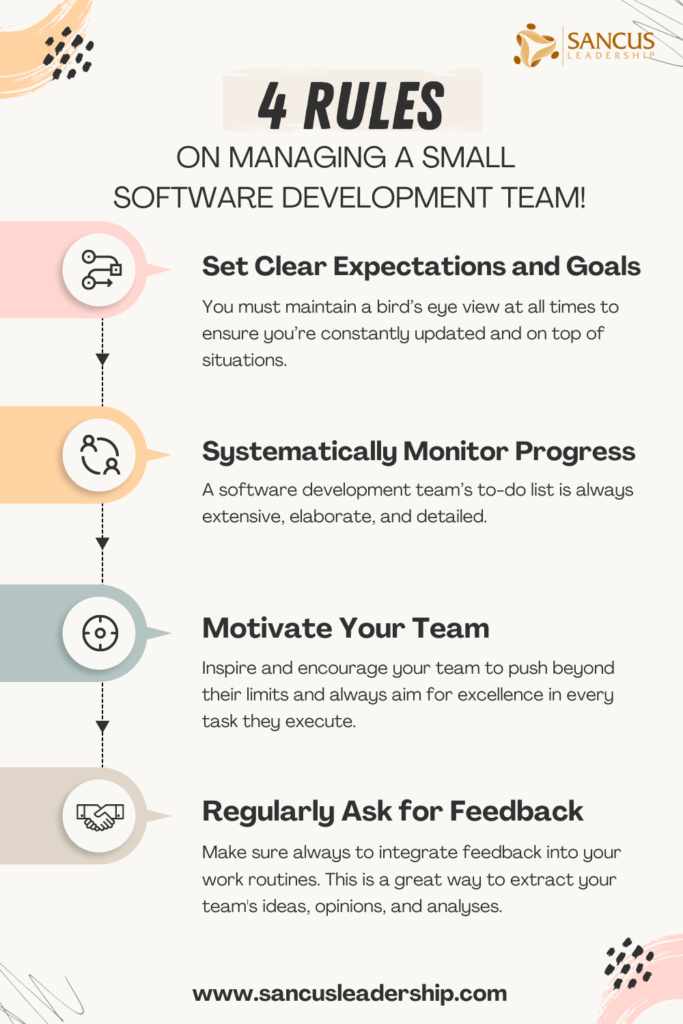Your cart is currently empty!

The 4 Rules of Managing a Small Software Development Team!
Managing a small software development team is more complex than it sounds. You don’t need to be updated on all the ins and outs of coding and the technicalities of programming. But small dev teams have unique needs and challenges to understand to lead effectively and thoroughly.
You can manage a small development team by setting clear goals from the onset and plotting a well-defined plan of action with your team. Collaborate with them on the best strategies to employ. Ensure you are updated on each developmental phase by establishing monitoring and feedback systems.
Read on to learn more about how you can efficiently manage a small development team (and how it compares to a larger one), even if you’re not an expert in programming and coding. We will talk about setting well-defined goals, staying on top of the situation at each development phase, and keeping your team engaged and committed to delivering top-quality output. I will also provide leads on some of the best project management tools you can use.
How Do You Manage a Small Software Development Team?

You can effectively manage a small development team by being organized and always on top of any situation. Establish a solid feedback and monitoring system to stay in tune with your team and keep track of deadlines. Maintain open lines of communication to promote transparency.
Here are the 4 rules you must take a closer look at:
1. Set Clear Expectations and Goals
The secret to ensuring your team members function synergistically and deliver your output promptly is your effectiveness in setting well-defined objectives for your team. Many details go into developing high-quality software, and, as a leader, you must maintain a bird’s eye view at all times to ensure you’re constantly updated and on top of situations.
The secret to ensuring your team members function synergistically and deliver your output promptly is your effectiveness in setting well-defined objectives for your team.
Here are some tips:
- Set well-defined goals. Make sure to define the job scope, expectations, and needs that must be filled.
- Set a specific timeframe. Establish the timeline so each team member knows exactly how much time should be allotted for various tasks. The team should know exactly what tasks need to be done and when each should be accomplished. The team must consistently be on the same page.
- Put everything in writing. It becomes much easier to stay on top of the situation if you can easily keep track of things. Plan extensively and record every minute detail in a notebook or your laptop. You can also install a large whiteboard in a common area in the workplace so your team members can easily access information whenever they need to.
| Tips for Expectation and Goals | Description |
| Set well-defined goals | Make sure to define the job scope, expectations, and needs that must be filled. |
| Set a specific timeframe | Establish the timeline so each team member knows exactly how much time should be allotted for various tasks. |
| Put everything in writing. | Plan extensively and record every minute detail in a notebook or your laptop. |
Software development is a lengthy process that requires meticulous planning and acute attention to detail. Plating your course early on is crucial so the whole team is well-versed as you progress through each stage.
Here are the basic steps involved in the software development process and some tips on how to efficiently navigate through them:
Analysis and Information-Gathering
This stage is where everyone gathers to discuss the basics of the product. Some pertinent issues to be addressed include:
- What will be the product’s output?
- What are the requirements for creating such a product?
- What is the product’s state of feasibility and practicality?
- What are the requirements to successfully run the product?
- How much time will you need?
- How much will it cost to develop?
Product Design and Development
This stage involves understanding the specifications of the product itself and the support it requires to function properly. Some details to be discussed and settled at this stage include:
- Development platform to be used (Java, iOS, .NET, etc.)
- Product architecture
- Prototyping
- User interface that suits the target market’s needs and expectations (take into account product features, such as user-friendliness and overall look)
Some questions you might need to address are:
- Who is your target market?
- What’s the typical profile of your end-users?
- What will the product be used for?
Coding
Here is where all plans and strategies formulated will finally be implemented. At this stage, software developers will begin the programming process. Essentially, this is where they develop codes that instruct computers precisely what to do in a given scenario.
An individual’s skills and experiences in the field will come in handy in developing a product that meets all the requirements and addresses all the needs previously discussed. Be keen on pinpointing each team member’s strengths and utilizing them for the project. Also, strive to identify weaknesses so they can promptly be addressed and you end up with a skilled, well-rounded team.
Consider pairing individuals who complement each other based on skills and experience level. Pair a newbie with a tenured team member to allow the former to extract valuable hands-on learnings and experiences. You can also group your team members based on their level of expertise to make your team more efficient and collaborative.
Testing
Testing is crucial to ensuring you deliver a relevant and high-quality product. The software developers will test the product’s functionality, checking for bugs and other potential issues. The end-users’ point of view will be the central focus.
Be open to making adjustments and changes based on testing results. The goal here is to develop the best product that addresses the need you identified at the beginning of the project. Trust your team members’ opinions and feedback, then react accordingly by making sound decisions with them on the following steps.
Product Roll Out
Once the product passes the testing stage, the product can be deployed to the end users. This is a critical phase of the software development process because unforeseen and overlooked problems may still arise.
Your responsibilities continue after you deploy your product. Once released, it is your team’s job to ensure that operations run smoothly. Product maintenance is still part of your team’s responsibility, and it is up to you as the leader to ensure your team is up to the challenge.
At this stage, managing your team involves ensuring they stay committed to the after-market phase of the project. Formulate an efficient monitoring strategy so everyone is updated on the product’s progress, whether it’s good or bad news. Be keen on addressing any concerns because doing so reflects your team’s integrity, reliability, and professionalism.
| Steps involved in the software development process | Description |
| Analysis and Information-Gathering | This stage is where everyone gathers to discuss the basics of the product. |
| Product Design and Development | This stage involves understanding the specifications of the product itself and the support it requires to function properly. |
| Coding | Here is where all plans and strategies formulated will finally be implemented. At this stage, software developers will begin the programming process. |
| Testing | The software developers will test the product’s functionality, checking for bugs and other potential issues. The end-users’ point of view will be the central focus. |
| Product Roll Out | This is a critical phase of the software development process because unforeseen and overlooked problems may still arise. |
2. Systematically Monitor Progress
A software development team’s to-do list is always extensive, elaborate, and detailed. With many tasks, it can be easy to feel overwhelmed and lose track of progress.
The key is to delegate tasks accordingly, to bank on each team member’s unique strengths to ensure that the best possible person for handling each role is on the job. Then closely monitor progress by tracking deadlines and asking for regular updates from your team.
Here are some tips to help ensure a smooth ride:
- Prioritize. Categorize tasks based on urgency and importance (Eisenhower matrix). Consider putting off jobs with a lesser importance.
- Make space for dilemmas and glitches. Remember that many things may go differently than planned in software development. You must be prepared to handle unforeseen challenges, such as malfunctions, software bugs, and system errors.
- Highlight deadlines. Missed deadlines put the team’s reputation at risk and can make your company incur unimaginable losses. Make a calendar so you can quickly rank deadlines against each other.
- Ask for real-time updates. Regular team updates help you stay on top of the situation. Leading a team means knowing crucial aspects, particularly when multiple deadlines loom. The team needs a solid, sensible leader who isn’t easily fazed by pressure and can keep their head on straight despite the stress.
| Tips to ensure a smooth progress | Description |
| Prioritize | Categorize tasks based on urgency and importance. |
| Make space for dilemmas and glitches | Remember that many things may go differently than planned in software development. |
| Highlight deadlines | Missed deadlines put the team’s reputation at risk and can make your company incur unimaginable losses. |
| Ask for real-time updates | Regular team updates help you stay on top of the situation. Leading a team means knowing crucial aspects, particularly when multiple deadlines loom. |
3. Motivate Your Team
Inspire and encourage your team to push beyond their limits and always aim for excellence in every task they execute. Uncover their needs through your regular feedback sessions and provide them with the support they require. This is a great way to establish trust and openness within the team.
Effectively managing a small team also gives them room for growth. At Sancus Leadership, we know the value of utilizing our team member’s strengths to boost the team’s success and working on identified weaknesses so they don’t impede the team’s progress.
Remember, your team members are critical thinkers since their job is to provide optimal solutions to tricky problems posed by clients. Offer opportunities for development in their field through continuing education programs, training sessions, and symposia. Please give them the freedom to unleash their creativity and expertise rather than micromanaging their every move.
4. Regularly Ask for Feedback
Make sure always to integrate feedback into your work routines. This is a great way to extract your team’s ideas, opinions, and analyses. You can then use the information you gather to tweak the system and improve the team’s functions.
Managing a team means you must be in tune with what your employees are thinking and how they’re feeling. Not everyone will respond to your efforts, so asking the right questions is crucial. Be consistent about asking for feedback, so your team will appreciate your openness and sincerity.
Here are some questions you might want to consider asking your employees:
- Which accomplishment are you exceptionally proud of this week?
- How do you feel about the direction our team is going?
- I’ve been working on Project X with Y. What do you think about our progress so far?
- How can I better support you?
- Where do you see yourself, professionally, in 5 years?
- Which project did you least like working on? Why?
- What should we have done differently with Project X?
- Do you feel valued and appreciated by the team?
- What or who inspires you to succeed in your job?
- Are there any ideas about Project X you’d like to share with me?

Is There a Difference in Managing a Small vs. a Large Team?

Managing a small development team is different mainly because of the difficulty of truly understanding members’ strengths and weaknesses on a large team. People management is at the core of your role as a team leader. Naturally, the fewer people you need to manage, the more time you can dedicate to each person’s needs.
Here are some of the more prominent differences in managing small and large teams:
| Personality Differences | The more people there are in your team, the more diverse the personalities, quirks, needs, and wants you’ll have to deal with. More people to manage will make it more challenging for you as the leader to address all their concerns. |
| Efficiency and Speed | With a higher headcount for larger teams, efficiency and the speed with which tasks are accomplished may be more favorable. However, you also run the risk of harboring free-loaders in the team, so be mindful of proper task delegation. With smaller teams, it’s easier to manage task delegation and monitor progress. |
| Team Dynamics | Interpersonal relationships within the team tend to become more complicated with more people involved. With smaller teams, relationships tend to be more genuine and profound. |
| Team Morale | It’s much more challenging to keep morale up with more people on the team. With smaller teams, you can cater to their needs and expectations quicker. |
| Efficiency and Productivity | Both small and large teams face difficult challenges, but smaller teams are more prone to experiencing burnout and extreme pressure. People from smaller teams typically handle multiple roles, while those from larger teams have more specific responsibilities. |
Tools To Help You Manage a Small Development Team

Leading a team, whether small or large, places a massive weight on your shoulders. The good news is that plenty of support is available, especially if you’re new to this field, would like to enhance your management skills further, or would like to make this arduous responsibility easier to tackle.
Here are some project management tools you can explore and utilize to help make managing a small development team easier:
- Kanban. It’s a great tool if you like visualizing your team’s workflow. It lets you easily track your team’s progress with notifications, reporting features, and document-sharing.
- Asana. It can emphasize collaboration and recurring tasks. It can effectively manage your calendars, projects, timelines, and jobs. It integrates with Gmail, making the experience more streamlined.
- Monday.com. It is what we use at Sancus Leadership, and It has a visually appealing and user-friendly interface that offers a more transparent way to organize the team’s tasks. You can personalize calendars and lists to help you track progress better.
Here’s a video discussing some principles and simple rules on how to manage better and organize your software development team.
Key Takeaways
Collaborate with your team to establish the best action plan, then select a solid feedback and monitoring system where everyone can keep abreast of developments and deadlines. You must motivate your team to succeed, so they’ll be inspired to always aim for excellence and perform their roles in helping the team achieve.
